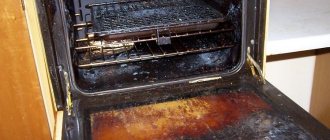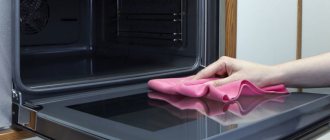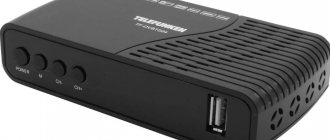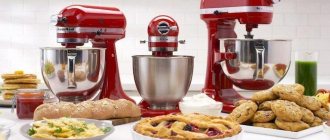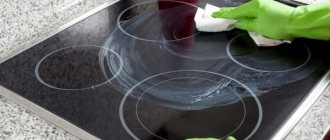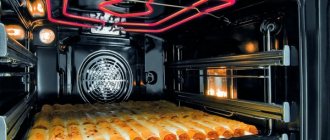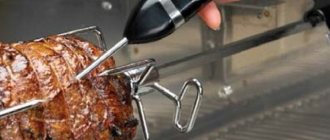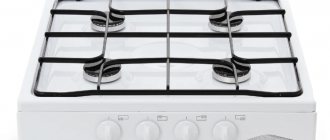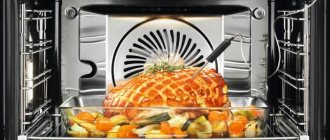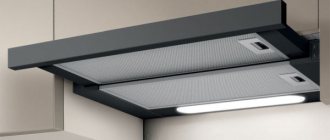Cleaning the oven from grease and burnt food is one of the most time-consuming household tasks. To facilitate cleaning, modern stoves use catalysis, pyrolysis and hydrolysis processes.
The most effective method is considered to be catalytic cleaning of the oven, which allows you to oxidize fat directly during the cooking process - we will explain what this is later.
What does it mean?
Catalysis is the acceleration of a chemical process that occurs under the influence of a specific substance (catalyst). During the reaction, this substance does not change its properties and composition, which ensures the possibility of repeated use.
The catalytic cleaning method is based on the rapid oxidation of fat that settles on the oven walls during baking.
The end products of this reaction are carbon and water, but other organic substances can also form if the temperature is too low. After the oven has cooled, dirt can be removed with a sponge or microfiber cloth .
To make cleaning easier, special panels are installed on the walls of the device. They are treated with enamel, which has large pores and contains a catalytic substance. The porous surface increases the contact area between the fat and the reagent. Compounds of cerium, copper, cobalt and manganese act as catalysts.
Catalyst substances do not mix with reaction products , so cooking in an oven with special enamel is completely safe.
Features of hydrolysis oven cleaning
As the name suggests, hydrolysis cleaning is the dissolution of contaminants under the influence of water vapor.
As a result, the dirt softens and after the oven has cooled, all that remains is to rinse the surfaces, racks and baking sheets in running water, and, if necessary, clean with a sponge. This method requires much less time and effort than regular cleaning, but the need to use a sponge and fuss with soot can be considered a definite disadvantage.
The catalytic method involves the use of special enamel for coating. This material does not allow fat to “eat” into the surfaces and harden, which makes cleaning the oven compartment easier.
As mentioned above, hydrolysis is a cleaning method using water vapor, and with a catalytic system, surfaces get rid of plaque and carbon deposits due to the characteristics of the panel coating.
Both methods are used not only in electric, but also in gas units, and this is a plus.
We invite you to familiarize yourself with Filtration of vegetable oil on the ABC apparatus
Continuing the comparative analysis, we can say that hydrolysis saves money (there is no need to purchase cleaning agents), and the catalytic method saves physical effort when washing surfaces, since it neutralizes grease. In addition, the catalytic panels will have to be replaced over time.
Which method is better is up to the hostess to decide; in this situation, it all depends on personal preferences.
A distinctive feature of the method of removing food residues using steam is its versatility.
Getting rid of dirt using hot steam is effective only for fresh stains.
Hydrolysis is used in all types of ovens. This method is suitable not only for ovens, but also for microwave ovens.
It should be taken into account that frequent use of hydrolysis causes corrosion of materials. To prevent this situation, you need to opt for models in which the coating is made using high-quality enamel.
Fat accumulations fall into a bowl of hot water. If there is a small amount of dirt on the walls of the device, they can be easily removed. To ensure high-quality cleaning that is safe for the coating, use a soft sponge or cloth.
The essence of the method is that water in a volume of 0.5 liters is poured into a heat-resistant vessel or oven tray. The liquid is heated at a temperature of 90 degrees. Hot steam softens all old dirt.
Be sure to read:
How to light the oven in a gas stove Hephaestus, Greta, Indesit and others
Some models use hydrolysis fluid instead of water. In addition, modern ovens are equipped with an activation function according to a timer, adjustment of cleaning intensity, and process duration.
After steam cleaning is completed, allow the unit to cool. Next, the remaining dirt is removed manually. Allow the oven to dry with the door slightly open for one hour.
The advantages of hydrolysis cleaning include several important factors:
- Low cost and simple process.
- Low level of energy costs.
- Eliminate the possibility of getting burned.
- There is no need to use aggressive, dangerous cleaning agents.
- Cleaning takes 15-30 minutes.
The method also has a number of disadvantages:
- The remaining softened dirt is removed manually.
- The method effectively removes only fresh dirt.
- There is a possibility of damage to the internal coating of the unit.
Some modern models are equipped with additional bells and whistles to improve the hydrolysis cleaning system:
- The “Cleaning” function consists of using special liquids for spraying. To do this, the device is heated to a temperature of 90 degrees. This indicator must be maintained for 15 minutes. After heating, a cleaning spray is applied to the surface. After the cycle is completed, any remaining grease and moisture is removed manually using a cloth.
- The "Aqua clean" function is used at low temperatures. To activate the program you need 0.5 liters of water. The optimal cleaning temperature is 50 degrees. The process takes exactly half an hour. After cleaning is completed, the oven is wiped with a cloth and dried. Place the pan back into the oven. In this case, the door must be open for at least one hour.
How is the oven cleaned?
Catalytic cleaning does not require specific preparation. During the cooking process, small drops of fat fall on the walls of the oven and are distributed over the porous surface, which absorbs dirt.
Oxidation begins at relatively low temperatures (from +140...150°C) , but most effectively occurs at a temperature of +200...250°C.
Lipid decomposition occurs simultaneously with food preparation. While maintaining the required temperature, the catalyst oxidizes adhering fat and dirt until a new layer settles.
At the end of the process you must:
- wait for the oven to cool completely;
- remove the grill or baking tray;
- wipe the working panels with a soft sponge or cloth;
- wash other surfaces.
If necessary, you can postpone cleaning the oven and immediately start cooking another dish. It may take several cleaning cycles to remove old and thick layers of grease.
As a rule, catalytic panels are installed on the walls of the oven (top, back and sides), as well as the convector. The bottom and inside of the door must be cleaned using traditional methods.
These limitations are due not only to the cost of the panels, but also to their instability to glucose. If the enamel also covers the bottom of the oven, then dripping sweet juice or caramel can damage the coating.
Oven self-cleaning using catalysis
Cleaning a catalytic oven
What is catalytic oven cleaning? This method is based on the principle of catalysis. Inside the chamber, under the influence of temperature and thanks to the presence of a special oxidation catalyst, a chemical reaction occurs. As a result, various contaminants are removed from the surface.
The Provence style oven Korting OKB 482 CRSB has a capacity of 60 liters, which allows you to cook a whole duck. Acid enamel applied to the inner walls of the oven helps dissolve all contaminants that fall on it during cooking.
Terms of use
To maintain the functionality of catalytic panels you need:
- If sugar or dairy products come into contact with the surface, wipe off the stains as soon as possible with a soft, damp sponge.
- Do not use hard scourers, metal scrapers or acid-based products to clean the oven.
- Avoid contact of sharp metal objects and enamel.
- Choose gels and liquid products for cleaning, and immediately after catalytic oxidation, wipe the coating only with a damp sponge without detergent.
If necessary, catalytic panels can be cleaned with cleaning products based on alkalis and surfactants.
Catalytic self-cleaning
The basis of the operating principle of this technology is the decomposition of fat accumulated after cooking into soot and water, which will then be absorbed by sorbent particles. The bosch oven self-cleansing occurs as soon as you turn on the oven and set the temperature to at least 140 degrees. The technology achieves maximum efficiency at 200 degrees. You don't need to enable, activate or do anything additional. The process is completely automatic.
- Virtual reality helmet for PC
- Homemade boiled pork: recipes
- Strengthening nails with acrylic powder for gel polish step by step
Pros and cons of the method
The catalytic oven cleaning method has a number of advantages:
cleaning up dirt can be combined with cooking, since the operating temperature of catalytic oxidation ranges from +200°C;- the catalysis process does not require large amounts of electricity or gas;
- reagents in enamel are completely safe for products;
- catalysis removes not only fresh, but also old fat, so cooking at maximum temperatures is not necessary all the time;
- ovens with a catalytic cleaning system can be either electric or gas.
The cost of such devices varies depending on the manufacturer, power and panel configuration. Ovens with catalytic cleaning are available in all price categories.
The disadvantages of the method include the following aspects:
- this method is intended only for removing fat, but is ineffective against other types of contaminants (sugar, milk protein, etc.);
- the panels have a short service life (200-300 hours), after which they need to be replaced;
- For effective cleaning, you need to turn on the high-temperature mode regularly.
Panels with a catalyst are sold separately from ovens; you can replace them yourself or at a household appliance service center.
Advantages and disadvantages of catalytic purification
Kitchen stoves with catalytic cleaning appeared on the market relatively recently, but a large number of housewives have already appreciated their convenience. The advantages of this type of kitchen appliances are:
- cleaning occurs automatically, this is a chemical reaction when the catalytic substance reacts to the influence of temperatures;
- energy savings due to the fact that cleaning occurs during the cooking process and there is no need to start the oven separately;
- the versatility of the system, it is suitable for any type of oven;
- affordable cost and safety.
Thanks to these advantages, stoves with catalytic cleaning have gained popularity among modern housewives. But there are also disadvantages:
- the cost of an oven directly depends on the quality of the material used; appliances with a high-quality cleaning system are more expensive than analogues made from cheap material;
- special enamel covers only the walls of the ovens, sometimes even the bottom, but the housewife will have to wash off the grease and carbon deposits from the inner surface of the door herself;
- Over time, the coating loses its properties, and after 250–300 hours of use there will be a need to replace the catalytic panel.
Some manufacturers produce oven models equipped with double-sided catalytic panels. When the coating on one side loses its cleaning functions, the panel can be turned to the other side.
Which method is better - mechanical, steam, manual or pyrolysis?
In addition to catalysis, the purification system can be based on the following processes:
- hydrolysis of fats;
- mechanical removal of contaminants (traditional method);
- pyrolysis;
- rejection of fat molecules by a smooth, non-porous surface (enamel for easy cleaning).
Advantages and disadvantages of other purification methods compared to catalysis:
| Method | a brief description of | Advantages | Flaws |
| Pyrolysis | Complete fat burning at temperatures up to 500°C | It is highly efficient. No need to change working panels | Requires a lot of energy. An additional warm-up operation is required. It has a high cost. Reliable door locking system required |
| Hydrolysis | Softening fat with water vapor at 90°C | Can be used in the simplest and most budget oven models. No replacement parts. Occurs at low temperatures. Can be used for any type of contamination | Additional heating with steam and mechanical cleaning are required afterwards. Fat is removed only after the surfaces have cooled. Ineffective against old fat |
| Easy clean enamel | Manual cleaning of the surface with a soft sponge | The coating is resistant to acids and sugar. Enamel protects all interior surfaces of the oven | This enamel is more sensitive to scratches and damage and cannot be replaced. If the coating is damaged, corrosion of the base metal occurs |
| Traditional | Mechanical cleaning with a sponge and solutions of soaps and alkalis | Can be used in all types of ovens. Does not require special coating. Efficiency does not depend on the nature of contamination | Using abrasives may damage the anti-corrosion layer. Labor-intensive, low efficiency. Requires hand protection due to the use of alkalis |
Some oven models are equipped with a catalytic hydrolysis cleaning system, which makes it easy to clean all surfaces even at low temperatures. Read about hydrolysis cleaning here, about traditional cleaning here.
Pyrolytic oven cleaning - what is it?
The next way to get a clean oven interior is through the pyrolysis cleaning process. What it is? The essence of the method is contained in the name itself, since in translation from Greek “pir” means “heat”, and “lysus” means “decay”. Otherwise, this technology is called thermal decomposition, since to remove residual fat it is necessary to heat the interior of the oven to at least 450°C.
Under the influence of such high temperatures, all organic compounds simply burn to form ash, which is simply removed from the oven with a cloth after it has cooled. Through pyrolysis it is possible to cope with even the most severe pollution
IMPORTANT ! The pyrolysis process is only possible in electric models, since gas devices are not capable of heating above 250°C.
Advantages and disadvantages of the method
This method also has a number of invaluable advantages, which are accompanied by disadvantages. They should be taken into account if you want to become the owner of an oven with pyrolysis cleaning. The advantages of the method are:
- high efficiency. When choosing which method of cleaning ovens is better, pyrolysis confidently takes a leading position, since through this technology it is possible to get rid of even the oldest and most severe contaminants;
- versatility, allowing the removal of all types of plaque;
- cleaning the entire area of the oven, which is especially important for removing dirt in places where using another method would only require manual cleaning;
Ovens for pyrolysis cleaning are equipped with special heat-resistant glass
- no need to use household chemicals, which leave behind a residue and an unpleasant odor that affects the quality of food.
The disadvantages of this cleaning method are:
- higher cost of equipment with pyrolysis, which is caused by the use of heat-resistant types of steel and specially tempered glass to withstand elevated temperatures;
- duration of the cleaning process, which can last up to 2 hours;
- energy consumption, the value of which depends on the degree of pollution, but on average varies from 4 to 7 kV;
- requirements for surrounding furniture, which must also withstand rising temperatures;
- presence of an unpleasant odor. An oven equipped with a pyrolysis function has special filters to capture odors, but if they are heavily soiled, they simply may not cope with the assigned task.
Gas ovens do not have the pyrolysis function because they cannot heat up to the required temperatures
How to use pyrolysis correctly
In order for the pyrolysis cleaning process to be of high quality, a number of rules must be observed, which also ensure the safety of others during the procedure:
- You should first remove baking sheets and racks from the oven, which are simply not designed for such temperature conditions.
- When choosing a specific model, you should pay attention to the presence of a door lock function, which should turn on when the temperature rises to 200°C.
- It is recommended to carry out cleaning at least once a month to prevent the accumulation of significant carbon deposits. Many modern stoves are equipped with a special catalyst that determines the degree of contamination and notifies the owner of the need for cleaning.
IMPORTANT ! Even with a lock, inexpensive models experience significant heating of the glass, so it is advisable to keep children away from the stove during cleaning.
When cleaning with pyrolysis, keep children away from the stove as the door can become very hot.
Reviews
The catalytic cleaning system has mostly positive reviews . Consumers note that it significantly reduces the duration and complexity of cleaning, although the panels do not cover all surfaces of the oven.
Despite its lower efficiency compared to pyrolysis and the need to replace panels, catalysis has the great advantage of being able to combine cleaning and cooking.
However, with frequent use and baking of desserts, the catalytic system is less beneficial than hydrolysis or easy-clean enamel. Reviews can be found here, here and here.
Hydrolysis oven cleaning
Another convenient way to clean your oven from grease is hydrolysis cleaning. It is carried out using water and consists of the following:
- Water and cleaning agent are poured into the container.
- The container is placed in the oven for 20-30 minutes at a temperature not exceeding 90 degrees.
- Under the influence of steam, the fat is cleaned, and after the process is completed, all that remains is to wipe it off with a rag.
It is important to understand that hydrolysis is not so much a self-cleaning method, but rather a convenient and quick way to deal with contaminants. It can only be used if the fat has not had time to dry.
Advantages of the method:
- Low cost.
- Low energy consumption.
Flaws:
- Not a self-cleaning method.
- The method is effective only in cases where the dirt is fresh.
- Do not use immediately after you have finished cooking. This is because the oven will be too hot to use this method.
Even experts do not always know which cleaning method is right for your oven. But there are several inventions that will help make your work easier:
- Possibility to install a removable door on the oven.
- Installation of a special design that pushes the entire working part of the oven out and allows you to completely remove it.
Useful tips
Useful tips for using the oven:
- Before cleaning enamel panels, apply a little detergent to hard-to-reach areas using an old toothbrush or soft brush.
- For persistent stains, heat a baking tray in the oven with water to which a little soda, detergent or ammonia has been added.
- When baking at +170…190°C, use foil, parchment or a baking sleeve.
- When baking sweet dishes, place an additional baking sheet below the level of the main rack.
